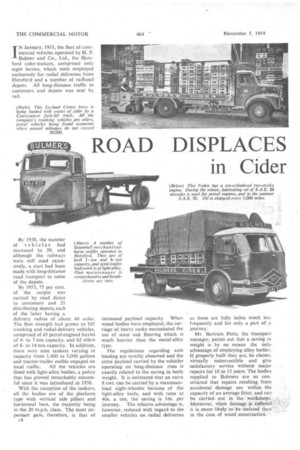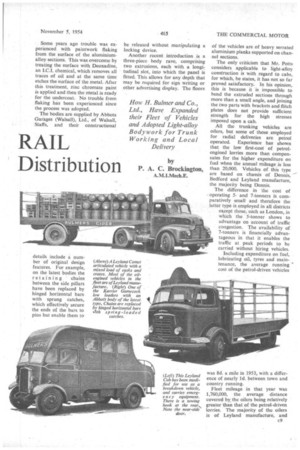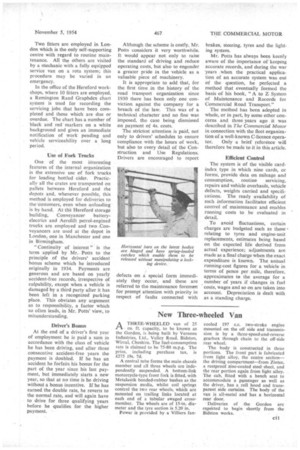ROAD DISPLACES RAIL in Cider Distribution
Page 50

Page 51

Page 52

Page 53

If you've noticed an error in this article please click here to report it so we can fix it.
by
P. A. C. Brockington, IN January, 1933, the fleet of commercial vehicles operated by H. P. Bulmer and Co., Ltd., the Hereford cider-makers, comprised only eight lorries, which were employed exclusively for radial deliveries from Hereford and a number of railhead depots. All long-distance traffic to customers and depots was sent by rail.
By 1938, the number of vehicles had increased to 30, and although the railways were still used extensively, a start had been made with long-distance road transport to some of the depots.
By 1953, 75 per cent. of the output was carried by road direct to customers and 21 distributing depots, each of the latter having a delivery radius of about 40 miles. The fleet strength had grown to 105 trunking and radial-delivery vehicles, comprised of 43 petrol-engined lorries of 4to 7-ton capacity, and 62 oilers of 6to 14-ton capacity. In addition, there were nine tankers varying in capacity from 1,400 to 3,000 gallons and tractor-trailer outfits engaged on local traffic. All the vehicles are fitted with light-alloy bodies, a policy that has proved remarkably successful since it was introduced in 1938.
With the exception of the tankers, all the bodies are of the platform type with vertical side pillars and horizontal bars, the majority being in the 20 mph. class. The most important gain, therefore, is that of c8 increased payload capacity. When wood bodies were employed, the carriage of heavy casks necessitated the use of stout oak flooring which is much heavier than the metal-alloy type.
The regulations regarding axle loading are strictly observed and the extra payload carried by the vehicles operating on long-distance runs is exactly related to the saving in body weight. It is estimated that an extra 8 cwt. can be carried by a maximumload eight-wheeler because of the light-alloy body, and with rates at 40s. a ton, the saving is 16s. per journey. The relative advantage is, however, reduced with regard to the smaller vehicles on radial deliveries as these are fully laden much less frequently and for only a part of a journey.
Mr. Bertram Potts, the transport manager, points out that a saving in weight is by no means the only advantage of employing alloy bodies. if properly built they are, he claims, virtually indestructible and give satisfactory service without major repairs for 10 to 15 years. The bodies supplied to Bulmers are so constructed that repairs resulting from accidental damage are within the capacity of an average fitter, and can be carriedout in the workshops. Moreover, wl,tert damage is suffered it is more likely to be isolated than in the case of wood 'construction. Some years ago trouble was experienced with paintwork flaking from the surface of the aluminiumalloy sections. This was overcome by treating the surface with Deoxadine, an chemical, which removes all traces of oil and at the same time etches the surface of the metal. After this treatment, zinc chromate paint is applied and then the nietal is ready for the undercoat. No trouble from flaking has been experienced since the process was adopted.
The bodies are supplied by Abbots Garages (Walsall), Ltd., of Walsall, Staffs, and their constructional details include a number of original design features. For example, on the latest bodies the retaining • chains between the side pillars have been replaced by hinged horizontal bars with sprung catches, which effectively secure the ends of the bars to pins but enable them to be released without manipulating a locking device.
Another recent introduction is a three-piece body rave, comprising two extrusions, each with a longitudinal slot, into which the panel is fitted. This allows for any depth that may be required for sign writing or .other advertising display. The floors
of the vehicles are of heavy serrated aluminium planks supported on channel sections.
The only criticism that Mr. Potts considers applicable to light-alloy construction is with regard to cabs, for which, he states, it has not so far proved satisfactory. In his opinion, this is because it is impossible to bend the extruded sections through more than a small angle, and joining the two parts with brackets and flitch plates does not provide sufficient strength for the high stresses imposed upon a cab.
All the trunking vehicles are oilers, but some of those employed for radial deliveries are petrol operated. Experience has shown that the low first-cost of petrolengined lorries more than compensates for the higher expenditure on fuel when the annual mileage is less than 20,000. Vehicles of this type are based on chassis of Dennis, Bedford and Leyland manufacture, the majority being Dennis.
The difference in the cost of operating 5and 7-tonners is comparatively small and therefore the latter type is employed in all districts
except those, such as London, in which the 5-tonner shows to advantage on account of traffic congestion. The availability of 7-tonners is financially advantageous in that it enables the traffic at peak periods to be carried without hiring vehicles.
Including expenditure on fuel, lubricating oil, tyres and maintenance, the average running • cost of the petrol-driven vehicles was 8d. a mile in 1953, with a difference of nearly id. between town and country running.
Fleet mileage in that year was 1,760,000, the average distance covered by the oilers being relatively greater than that of the petrol-driven lorries. The majority of the oilers is of Leyland manufacture, and there is also a number of E.R.F. chassis with Gardner 4LK, 5LW or 6LW engines, and Fodens powered by Gardner 6LW units or Foden fouror six-cylindered two-stroke units.
Running costs of the off-engined vehicles vary appreciably as, between town and country, the average of the 6and 7-tonners being approximately 6d. a mile, and in the case of the 10and 11-tonners slightly over 8d. a mile. The 14-tonners operate at a cost of between 8d. and 9d. per mile and a 14-tonner, drawing a 5-ton trailer, at approximately 10d. With a 9-ton trailer the cost is increased to Ild, per mile. To the foregoing figures "standing charges" must, of course, be added.
Articulated Units
Tractor units operating in Hereford comprise Scammell mechanical horse 3-ton and 6-ton vehicles, with articulated trailers which include 16 6-ton units, of which the majority is fitted with alloy bodies.
A fully detergent lubricating oil of' high quality is used for both the oilengined and petrol-engined vehicles. The oilers operate on S.A.E. 20 lubricant throughout the year, and the petrol vehicles on S.A.E. 20 in winter and S.A.E. 30 in summer. The petrol vehicles have not yet been running for a sufficient period on detergent oil for an estimate to be made regarding its effect on bore wear, but it has been established that the oil prevents piston scuffing under arduous operating conditions in hot weather.
Formerly, piston trouble was experienced during the summer in London and other centres when continual use of the low gears was necessary. The oil is changed in both types of unit at 5,000-mile intervals.
No Bearing Troubles
The petrol engines normally require a top overhaul, including decarbonizing and valve grinding, every 10,000 miles, and in the country they average about 80,000 miles between major overhauls. When engaged on town work the mileage is often reduced to about 50,000. Although the total mileage covered by many of the oil-engined vehicles is approaching 200,000, none of the engines has yet required attention to the bearings.
The maintenance schedule of the oil engines includes decarbonizing and valve grinding after sthevehicle has covered 40,000 milts, and the fitting of new piston rings after
c10 80,000 miles, replacement parts being standard. At 120,000 miles a top overhaul is repeated and again at 160,000 .miles, when new pistons are fitted into the existing bores, or the cylinder sleeves are renewed together with the piston assemblies, according to the condition of individual units.
Although this schedule is based on the performance of the larger engines such as the Leyland 9.8-litre unit and the Gardner 6LW, the Leyland Comets with the 5-litre engine cover mileages between overhauls only slightly less than those quoted. The two-stroke units of the Fodens have
not covered a sufficient mileage for an estimate a their wearing qualities to be made, but they are operating very economically. For example, the 8-tonners, powered by the fourcylindered unit, average 14.5 m.p.g. on mixed town and country running.
Apart from machining the crankshafts and cylinder bores, petrol engines are completely overhauled in the workshops. Oil engines requiring attention to the crankshaft assembly will be replaced by factory-reconditioned units.
The advantage of running to a strictly legal schedule is indicated by the tyre mileages, which vary between 35,000 and over 50,000 according to the type of vehicle and the service. This excludes some country runs that are particularly hard on tyres as a result of a combination of a gritty surface and pronounced camber, which has reduced the average tyre-life of certain vehicles. All suitable covers are retreaded.
The interval between docks for routine maintenance depends upon the system of chassis lubrication. More than 50 per cent. of the vehicles has been fitted with Tecalernit Syndromic automatic lubricators, which have enabled the mileage between routine servicing to be increased from around 1,000 to. 2,000 miles.
This corresponds to the acceptable period before servicing is required, of other mechanical components, oil filters, and so on. The interval is based . on time, so that definite schedules can be arranged and the work organized according to an economical routine, but, in effect, the period is related to mileage with a fairly generous latitude.
The routine maintenance schedule is comprehensive, each dock involving about eight hours' work for one fitter per vehicle, but nearly 10 years' experience has shown that it pays a good dividend, in that involuntary stops through breakdown rarely occur.
Of the 21 distributing depots, the most northerly is Newcastle upon Tyne, and other boundary centres include Morriston in South Wales, Marks Tey in Essex and Southampton, with a large bottling and distributing depot in London, to which cider is supplied in bulk from Hereford in road tankers. Two fitters are employed in London which is the only self-supporting centre with regard to routine maintenance. All the others are visited by a mechanic with a fully equipped service van on a rota system; this procedure may be varied in an emergency.
In the office of the Hereford workshops, where 10 fitters are employed, a Remington Rand Graphdex chart system is used for recording the servicing jobs .that have been completed and those which are due or overdue. The chart has a number of black and redmarkers on a white background and gives an immediate notification of work pending and vehicle serviceability over a long period.
Use of Fork Trucks One of the most interesting features of the internal organization is the extensive use of fork trucks for loading bottled cider. Practically all the crates are transported on pallets between Hereford and the depots and, whenever possible, this method is employed for deliveries to the customers, even when unloading is by hand. At the Hereford storage building, Conveyancer batteryelectrics and Aerolift petrol-engined trucks are employed and two Conveyancers are used at the depot in London, one in Manchester and one in Birmingham.
"Continuity of interest" is the term applied by Mr.. Potts to the principle of the drivers' accident bonus scheme which he introduced originally in 1934. Payments are generous and are based on yearly accident-free records, irrespective of culpability, except when a vehicle is damaged by a third party after it has been left in a recognized parking place. This obviates any argument as to responsibility, a factor which so often leads, in Mr. Potts' view, to misunderstanding.
Driver's Bonus At the end of a driver's first year of employment he is paid a sum in accordance with the class of vehicle he has been driving, and after three consecutive accident-free years the payment is doubled. If he has an accident he forfeits his bonus for the part of the year since his last payment, but immediately starts a new year, so that at no time is he driving without a bonus incentive. If he has earned the double rate, he reverts to the normal rate, and will again have to drive for three qualifying years before he qualifies for the higher payment.
Although the scheme is costly, Mr. Potts considers it very worthwhile. It would appear not only to raise the standard of driving and reduce operating costs, but also to engender a greater pride in the -vehicle as a valuable piece of machinery.
It is appropriate to add that, for the first time in the history of the road transport organization since 1930 there has been only one conviction against the company for a breach of the law. This was of a technical character and no fine was imposed, the case being dismissed on payment of 4s. costs.
The strictest attention is paid, not only to drivers' schedules to ensure compliance with the hours of work, but also to every detail of the Construction and Use Regulations. Drivers are encouraged to report
defects on a special form immediately they occur, and these are referred to the maintenance foremen for prompt attention with priority in respect of faults connected with brakes, steering, tyres and the lighting system.
Mr. Potts has always been keenly aware of the importance of'keeping accurate records, and during the war -years when the practical application of an accurate system was out of the question, he perfected a method that eventually formed the basis of his book, "A to Z System of Maintenance and Records for Commercial Road Transport."
The method has been adopted in whole, or in part, by some other concerns and three years ago it was described in The Commercial Motor in connection with the fleet organization of a well-known C-licence opera
tor. Only a brief reference will therefore be made to it in this article.
Efficient Control The system is of the visible cardindex type in which nine cards, or forms, provide data on mileage and consumption, routine servicing, repairs and vehicle overhauls, vehicle defects, weights carried and specifications. The ready availability of such information facilitates efficient control of maintenance and enables running costs to be evaluated in detail.
To avoid fluctuations, certain charges are budgeted such as those relating to tyres and engine-unit replacements, estimates being based on the expected life derived from actual experience; adjustments are made as a final charge when the exact expenditure is known. The annual running-cost figures for a vehicle in terms of pence per .mile, therefore, approximates to the average for a number of years if changes in fuel costs, wages and so on are taken into account. Depreciation is dealt with as a standing charge.




















































































































